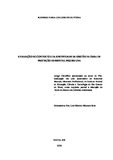Avaliação do contexto e da efetividade da gestão da área de proteção ambiental Piquiri-Una

Visualizar/
Data
2018-06-06Autor
Oliveira, Rodrigo Faria Collier de
http://lattes.cnpq.br/3331396102056754
Metadado
Mostrar registro completoResumo
The Environmental Protection Areas consist of Conservation Units belonging
to the category of Sustainable Use, endowed with biotic, abiotic and cultural attributes, with a certain degree of human occupation, that aim to protect biological diversity, discipline the
occupation process and ensure the sustainable use of its natural resources. Among them is the
Piquiri-Una Environmental Protection Area, the second largest Land Conservation Unit in the
State of Rio Grande do Norte, and which holds important rivers and forest fragments in the
rural Potiguar region. Coexisting with these riches, the Unit carries out several impacting
activities, such as the cultivation of sugarcane, livestock, illegal hunting, deforestation,
burning, silting and contamination of rivers, the existence of dumps, among others that
threaten biodiversity and sustainability. In view of this reality, this research had the objective
of evaluating the context and level of effectiveness of the management of the Piquiri-Una
Environmental Protection Area, using the method of Rapid Assessment and Prioritization of
Protected Areas Management, from 2013 to 2017, in order to evaluate its context and the
effectiveness of its management. The research was based on a case study, being characterized
as exploratory, starting from bibliographical research in books, articles, theses, dissertations
and documentary consultations in minutes of the meetings of the Management Council and in
the current environmental legislation. The results showed illegal hunting, waste disposal,
resource use by resident populations and pasture as the greatest pressures and threats in the
APA, which was also of great biological and socioeconomic importance measured at a rate of
78.8 % each, as well as an average vulnerability of 66.67%. For the management
effectiveness, a level of 56.81% was found, considered as average, with the objectives
(81.6%) and the decision-making processes (86.67%) considered as management's strengths.
Regarding its weaknesses, APA had the most fragile management element with a score of
23.2% in its infrastructure, which deserves greater attention, with emphasis also on human
resources (40%), research, evaluation and monitoring (40.67%), financial resources (44%)
and legal support (44.8%), which obtained average scores, but were considered alarming
because they jeopardized the achievement of the APA objectives. It is concluded that due to
the environmental and social importance of this PA, it is expected that management will be
applied more effectively for the coming years in order to overcome its shortcomings and the
main existing threats minimized.



